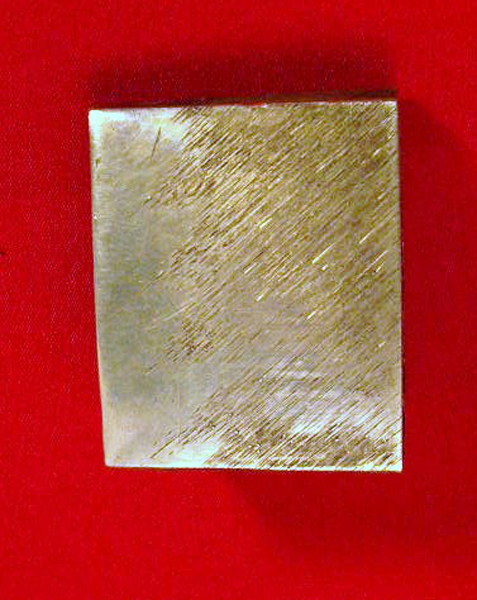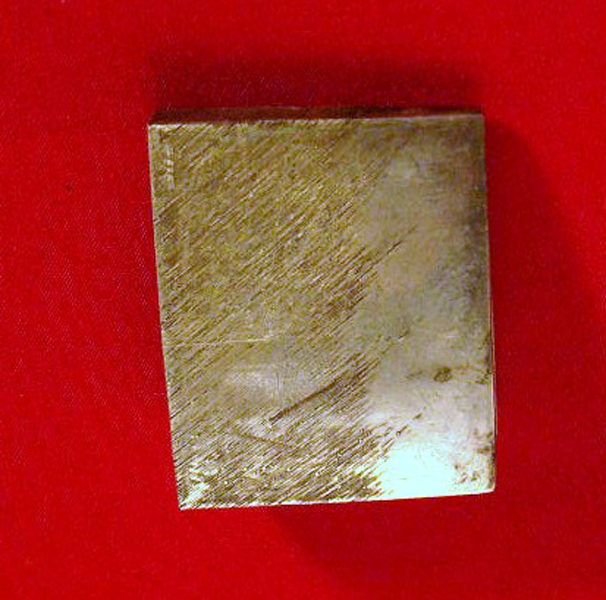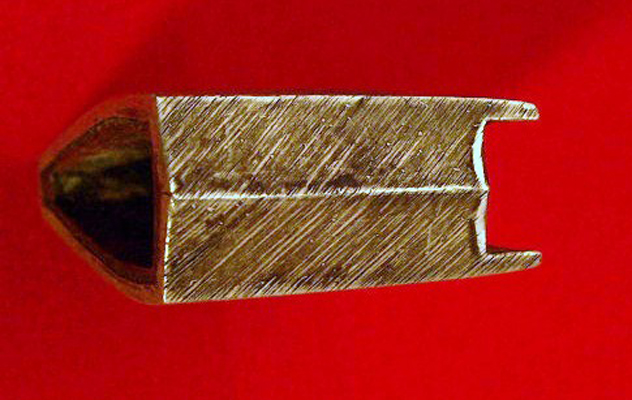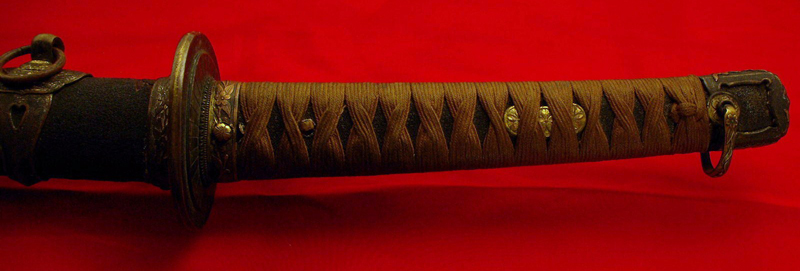Signature: YoShu SaiJo Ju SadaShige Tuskuru. Lucky day in Second Moon (around March) 1943. In commemoration of the end of the Great East Asia war.
Year Made: Showa
Forging Pattern: Masame
Tempering Pattern: Choji Midare
Dimensions: Nagasa: 25 13/16", Nakago: 8 5/16", Mihaba: 1 1/4", Sakihaba: 13/16", Kasane: 9/32", Sori: 1"
Mountings: Custom ordered high grade Navy Gunto with ishime lacquered saya. Some lacquer wear on the saya.
Overall Condition: The Gunto fittings are in good condition except for the saya which is cracked and chipped as can be seen in the pictures. The blade has hagiri. Imai Sadashige was one of the most important smiths during the war and made many swords for high ranking officers. He was born in 1891 and studied under Takahashi Yoshimune and Sadatsugu and was a teacher at the Japanese Sword Academy.
This is a very historically interesting sword. This sword with his long signature, imperial dating and a celebratory votive to the victory of WW2 inApril 1943. Made around the time when the Allied forces were turning the tide against the Japanese in Guadalcanal and surrounding islands and the death of Admiral Yamamoto, the Japanese mainland was perhaps unaware of the reality of the till October of 1943 when Hirohito proclaimed that their country's situation was "truly grave".
Sadashige's sword often have patriotic votives on their tangs, such as one made in 1945 that reads "General Yamashita wields this sharp sword to annihilate of our bitter enemy the US armed forces, crush and destroy tens of thousands of them with no mercy."
I could not help but think that this sword was forged under the best intentions and his best efforts to celebrate Japan's victory in the Pacific over the US that never came to be. Perhaps the Japanese Naval officer that commissioned this sword never returned to retrieve it. Perhaps it was put away when the reality of the war reached home. It is curious to see a sword made by a top ranked smith with hagiri, perhaps it was put in deliberately after news of the Japanese defeat with intention to destroy the sword. Or it happened during forging, which was a sign of things to come for Japan.
In any case, it is an ironic commemoration of the beginning of the US victory in the Pacific Theatre by one of Japan's most prominent smiths at the time. Although, I am sure he meant to celebrate a Japanese Victory.
Timeline of Pacific Theatre in 1943:
January 2, 1943 - Allies take Buna in New Guinea.
January 22, 1943 - Allies defeat Japanese at Sanananda on New Guinea.
February 1, 1943 - Japanese begin evacuation of Guadalcanal.
February 8, 1943 - British-Indian forces begin guerrilla operations against Japanese in Burma.
February 9, 1943 - Japanese resistance on Guadalcanal ends.
March 2-4 - U.S. victory over Japanese in the Battle of Bismarck Sea.
April 18, 1943 - U?:>.S. code breakers pinpoint the location of Japanese Admiral Yamamoto flying in a Japanese bomber near Bougainville in the Solomon Islands. Eighteen P-38 fighters then locate and shoot down Yamamoto.
April 21, 1943 - President Roosevelt announces the Japanese have executed several airmen from the Doolittle Raid.
April 22, 1943 - Japan announces captured Allied pilots will be given "one way tickets to hell."
May 10, 1943 - U.S. Troops invade Attu in the Aleutian Islands.
May 14, 1943 - A Japanese submarine sinks the Australian hospital ship CENTAUR resulting in 299 dead.
May 31, 1943 - Japanese end their occupation of the Aleutian Islands as the U.S. completes the capture of Attu.
June 1, 1943 - U.S. begins submarine warfare against Japanese shipping.
June 21, 1943 - Allies advance to New Georgia, Solomon Islands.
July 8, 1943 - B-24 Liberators flying from Midway bomb Japanese on Wake Island.
August 1/2 - A group of 15 U.S. PT-boats attempt to block Japanese convoys south of Kolombangra Island in the Solomon Islands. PT-109, commanded by Lt. John F. Kennedy, is rammed and sunk by the Japanese Cruiser AMAGIRI, killing two and badly injuring others. The crew survives as Kennedy aids one badly injured man by towing him to a nearby atoll.
August 6/7, 1943 - Battle of Vella Gulf in the Solomon Islands.
August 25, 1943 - Allies complete the occupation of New Georgia.
September 4, 1943 - Allies recapture Lae-Salamaua, New Guinea.
October 7, 1943 - Japanese execute approximately 100 American POWs on Wake Island.
October 26, 1943 - Emperor Hirohito states his country's situation is now "truly grave."
November 1, 1943 - U.S. Marines invade Bougainville in the Solomon Islands.
November 2, 1943 - Battle of Empress Augusta Bay.
November 20, 1943 - U.S. Troops invade Makin and Tarawa in the Gilbert Islands.
November 23, 1943 - Japanese end resistance on Makin and Tarawa.
December 15, 1943 - U.S. Troops land on the Arawe Peninsula of New Britain in the Solomon Islands.
December 26, 1943 - Full Allied assault on New Britain as 1st Division Marines invade Cape Gloucester.

















